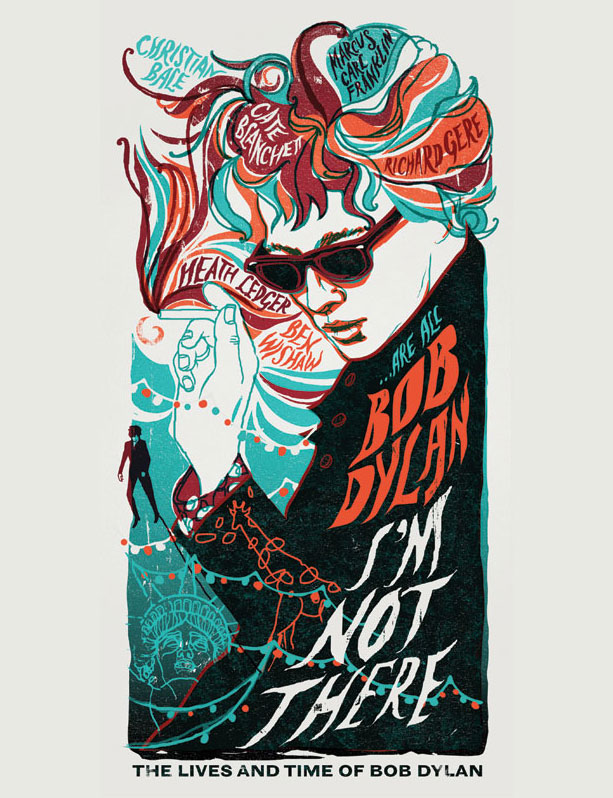The theories and opinions of the German philosopher Theodor Wiesengrund Adorno (1903-1969) on popular music and the culture industry are still highly influential in the domain of media studies. His thoughts about these subjects were very critical, pessimistic even. Adorno analysed the workings of the culture industry in terms of “standardization” and used the concept of “pseudo-individualization” to describe its effects on the listeners.
To extrapolate art from industrial was the enigma Bob Dylan composed with, and from which his flights to freedom, documented in the Todd Haynes film, I’m Not There, capably underscored. In the film, French poet Rimbaud says, ”The more you live a certain way, the less it feels like freedom”. It is the nature and contradictions between liberty, freedom and art which create the most interesting subtext of this film.
“A clear judgment concerning the relation of serious music to popular music can be arrived at only by strict attention to the fundamental characteristic of popular music: standardization.” This thesis is the starting point of one of Adorno’s first essays on popular music,and is also the paradigm of Bob Dylan, his efforts to sideswipe and avoid the cultural and commercial cliche’s throughout his career well exposed in the film ”I’m not There” His assumption of multiple musical personnas, with french poet Rimbaud offering counsel and context from the galleys demonstrates the friction between art, public acceptance and tension created, based on expectations and stereotyping. This musical dogmatism and intellectual rigidity was best exemplified by the scene of Pete Seeger trying to apply an axe to Dylans electric current at Newport in 1965.
” The whole structure of popular music is standardized, even where the attempt is made to circumvent standardization. Standardization extends from the most general features to the most specific ones. Best known is the rule that the chorus consists of thirty two bars and that the range is limited to one octave and one note. The general types of hits are also standardized: not only the dance types, the rigidity of whose pattern is understood, but also the “characters” such as mother songs, home songs, nonsense or “novelty” songs, pseudo-nursery rhymes, laments for a lost girl. Most important of all, the harmonic cornerstones of each hit — the beginning and the end of each part — must beat out the standard scheme. This scheme emphasizes the most primitive harmonic facts no matter what has harmonically intervened. Complications have no consequences. This inexorable device guarantees that regardless of what aberrations occur, the hit will lead back to the same familiar experience, and nothing fundamentally novel will be introduced.”( Theodor Adorno, On Popular Music )
The primary effect of this relation between the framework and the detail is that the listener becomes prone to evince stronger reactions to the part than to the whole. His grasp of the whole does not lie in the living experience of this one concrete piece of music he has followed. The whole is pre-given and pre-accepted, even before the actual experience of the music starts: therefore, it is not likely to influence, to any great extent, the reaction to the details, except to give them varying degrees of emphasis. Details which occupy musically strategic positions in the framework — the beginning of the chorus or its reentrance after the bridge — have a better chance for recognition and favorable reception than details not so situated, for instance, middle bars of the bridge. But this situational nexus never interferes with the scheme itself. To this limited situational extent the detail depends upon the whole. But no stress is ever placed upon the whole as a musical event, nor does the structure of the whole ever depend upon the details.( Adorno )
The vision of Dylan to approach ”popular” music from a point of departure of the serious is discomforting to many since the artistic value only gets its true meaning from layers of overall context. Only through the whole does Dylan’s music acquire its particular lyrical and expressive quality — that is, a whole built up of its very contrast with earlier themes of his work. Taken in isolation the later themes would be disrobed to insignificance. Generally, Dylan’s music is rarely a mere enforcement of a formulaic musical scheme, and the misunderstanding towards him is partly based on his stubborness and refusal to take details out of context.
Adorno’s analysis of Beethoven is applicable to Dylan’s best work and lends coherence to Dylan’s creative point of departure and overall conception of composition:” the detail virtually contains the whole and leads to the exposition of the whole, while, at the same time, it is produced out of the conception of the whole. In popular music the relationship is fortuitous. The detail has no bearing on a wholes, which appears as an extraneous framework. Thus, the whole is never altered by the individual event and therefore remains, as it were, aloof, imperturbable, and unnoticed throughout the piece.”
”Structural standardization aims at standard reactions. Listening to popular music is manipulated not only by its promoters but, as it were by the inherent nature of this music itself, into a system of response mechanisms wholly antagonistic to the ideal of individuality in a free, liberal society. ” The notion or illusion of popular music and particularly the usefulness and validity of protest songs was ridiculed by Adorno, and in ”I’m Not There” we see the same realization by Dylan, an acknowledgement of the limitations and a conscious de-leveraging of the role of prophet and standard bearer within a structure bound not to re
e what may have been noble intentions, though perceived with some naivety at the outset.”The composition hears for the listener. This is how popular music divests the listener of his spontaneity and promotes conditioned reflexes. Not only does it not require his effort to follow its concrete stream; it actually gives him models under which anything concrete still remaining may be subsumed. The schematic buildup dictates the way in which he must listen while, at the same time, it makes any effort in listening unnecessary. Popular music is “pre-digested” in a way strongly resembling the fad of “digests” of printed material.” ( Adorno )
It is hard not to argue that the mercurial, elusive talent of Dylan would intentionally provoke and antagonize, confound and confuse;These were likely intentional reactions as much as they were new musical details in a kaleidoscope of many musical movements in an overall symphony of his career.
The following quote from Adorno lends credence to the theory of copying the genre Dylan developed until saturated by repetition and commercial exhaustion, Dylan’s reaction to this industrial process and the reinforcement of his role as outsider; reclusive outlaw on the fringes who is threatened by the encroachment of psuedo progress and civilization on his more natural habitats.
” Imitation offers a lead for coming to grips with the basic reasons for it. The musical standards of popular music were originally developed by a competitive process. As one particular song scored a great success, hundreds of others sprang up imitating the successful one. The most successful hits types, and “ratios” between elements were imitated, and the process culminated in the crystallization of standards. Under centralized conditions such as exist today these standards have become “frozen”. That is, they have been taken over by cartelized agencies, the final results of a competitive process, and rigidly enforced upon material to be promoted. Noncompliance with the rules of the game became the basis for exclusion. The original patterns that are now standardized evolved in a more or less competitive way. Large-scale economic concentration institutionalized the standardization, and made it imperative. As a result, innovations by rugged individualists have been outlawed.”
In I’m Not There, there is an attraction to the bohemian, and Dylan’s lack of emotion on attaining the ”millionaire club”; more comfort mentally in riding the rail cars a la Woody Guthrie, than receiving awards, peddling causes, and exonerating guilt of wealthy white northern liberals at tuxedo only suppers. As his song ”A Pawn In Their Game” made clear:
” Concentration and control in our culture hide themselves in their very manifestation. Unhidden they would provoke resistance. Therefore the illusion and, to a certain extent, even the reality of individual achievement must be maintained. The maintenance of it is grounded in material reality itself, for while administrative control over life processes is concentrated, ownership is still diffuse.” ( Adorno )
A world of psuedo-individualization where the individuals are all variant of Barbie and GI Joe, differentiated by minor ”free choices” in attire and accessories. Dylan’s album ”World Gone Wrong” was a brilliant critique of pop culture, and his liner notes calling for a return to land and farming as dangerous form of revolutionary act, had more force than any protest song.






 COMMENTS
COMMENTS
Very usefull Info Thank You for sharing
Hi larry, thanks for reading. It was a good post.
It seems that you’ve put a good amount of effort into your article and I want a lot more of these on the web these days. I truly got a kick out of your post. I do not have a bunch to to say in response, I only wanted to register to say special work.
You are right. There is a lot of perspiration and a little inspiration that goes into these blogs! I think this is what its all about: the idea of meaningful networking begins with some authenticity. I like your site as well; solar energy has issues, but has enduring fascination. Thanks, Dave
Very usefull Info Thank You for sharing